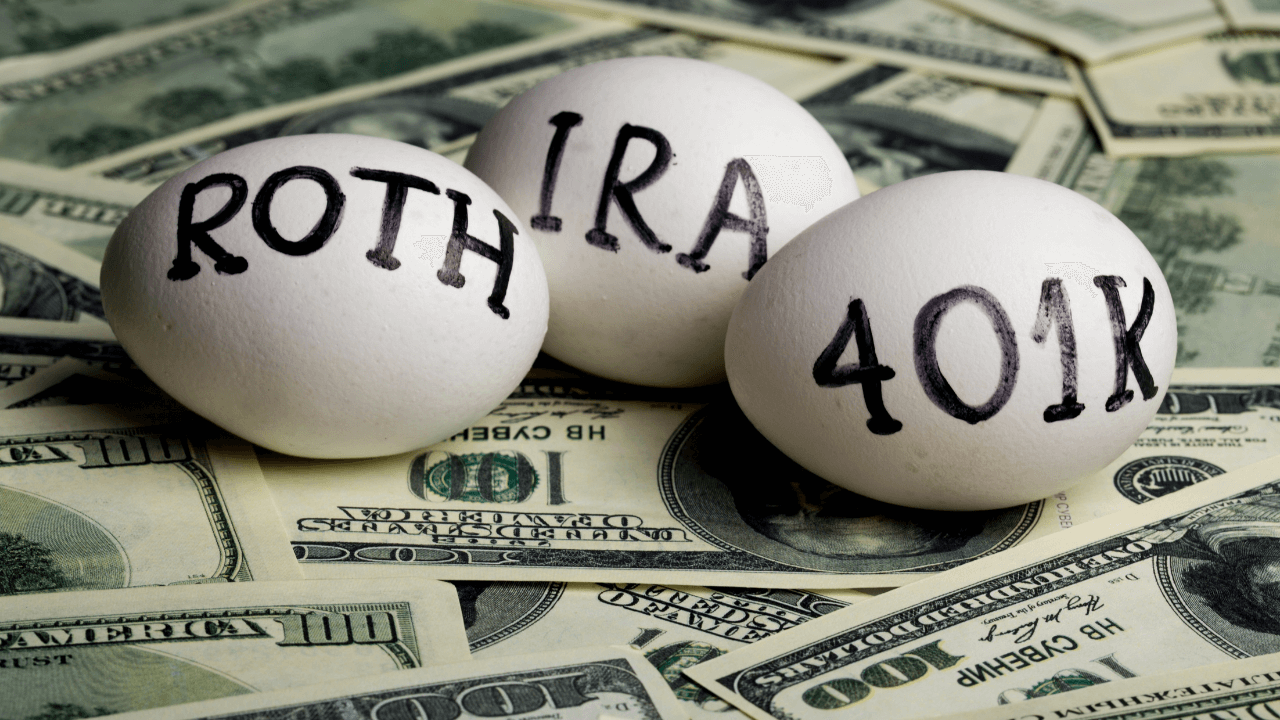Language:
Roth IRA Explained: Your Ultimate Guide

Ever wondered about saving for retirement but worried about taxes eating into your nest egg? A Roth IRA might be the perfect solution for you.
A Roth IRA is a powerful retirement account that lets you grow your money tax-free, allowing you to keep more of your hard-earned cash when you reach retirement age.
This guide dives deep into Roth IRAs—exactly how they work, the benefits they offer, and the eligibility requirements to see if you qualify. Yes, the contribution limits can get tricky, so we’ll clear up any confusion there. We’ll even cover how to avoid common pitfalls so you can get the most out of your Roth IRA.
By the end of this guide, you’ll be a Roth IRA pro—ready to make informed decisions about your retirement savings. You can confidently decide if a Roth IRA is the right fit for you and, if so, how to get started on a secure and tax-friendly retirement.
What Is a Roth IRA and Who Can Open One
A Roth IRA is a unique retirement account. Unlike traditional IRAs, where contributions might be tax-deductible upfront, Roth IRAs take a different approach.
You contribute money you’ve already paid taxes on, but the magic happens on the back end. Here’s the key benefit: if you follow the rules, all your retirement earnings and withdrawals are entirely tax-free.
So, how can you avail this tax advantage? Eligibility for Roth IRAs depends on two main factors — your income and how you file your taxes.
The IRS sets income limits that determine whether you can contribute directly to a Roth IRA. These limits change slightly each year, so it’s important to check the latest guidelines.
There’s also a minimum age requirement. You must be at least 18 years old to open a Roth IRA. But there’s no upper age limit! So, a Roth IRA could be valuable if you’re just starting your career or looking to ramp up your retirement savings closer to retirement age.
Here’s a quick recap: Roth IRAs are for anyone who wants tax-free growth on their retirement savings.
You can contribute after-tax dollars and watch them grow tax-free if you meet the income limits and age requirements. This can be a huge advantage, especially if you expect to be in a higher tax bracket in retirement.
Advantages of Choosing a Roth IRA

So, you’re sold on the idea of tax-free retirement income. But why exactly is a Roth IRA the better choice than other options? Let’s find out why:
Tax-Free Growth
Roth IRAs are all about tax-free growth. Every penny of earnings your investments generate inside the account adds up tax-free. This means your retirement savings have more room to grow.
Tax-Free Withdrawals
Once you reach age 59 ½ and have owned your Roth IRA for at least five years, qualified withdrawals are tax-free. This includes both your original contributions and the earnings generated over time. It’s like getting a double tax break — you pay taxes upfront on contributions, but everything grows and comes out tax-free in retirement.
Flexibility with Contributions
With a Roth IRA, you can withdraw your contributions anytime, penalty-free. Knowing your money isn’t wholly locked away gives you peace of mind. Remember, though, this flexibility only applies to your contributions. Earnings are subject to the age and account ownership requirements for tax-free withdrawals.
No Required Minimum Distributions (RMDs)
Unlike traditional IRAs, which require withdrawals at age 72, Roth IRAs don’t have RMDs. You can leave your contributions and earnings growing tax-free, allowing you to pass on more to your beneficiaries.
Potential Tax Benefit in Retirement
A Roth IRA becomes even more attractive if you expect to be in a higher tax bracket in retirement. Taking the tax hit upfront on contributions will lock in today’s tax rate for future withdrawals. This can be a smart strategy if you believe tax rates might climb in the future.
Contributions and Limits for Your Roth IRA
Now that you understand the benefits of a Roth IRA, let’s discuss contributions and the income limits you need to know.
How Much You Can Contribute Annually
Annual limits exist on how much you can contribute to your Roth IRA. The good news is that the IRS sets a generous contribution limit each year. It applies to everyone regardless of your age.
The limit for 2024 is $7,000. If you’re 50 or older, you get a bonus! You can contribute an additional $1,000 each year as a catch-up contribution, bringing the total limit to $8,000.
It’s also important to note that these limits apply to the total amount you contribute across all your IRAs, both traditional and Roth.
So, if you have both types of accounts, you’ll need to add your contributions to each to ensure you don’t exceed the limit.
There’s also a catch with eligibility based on your income. The IRS phases out Roth IRA contributions for higher earners. If your income reaches a certain level, you won’t be able to contribute directly to a Roth IRA.
However, there are workarounds, so it’s always worth checking with a finance expert like doola to see if you qualify for a Roth IRA and explore all your options.
Income Limits for Contributions
While Roth IRAs offer benefits, there are income limits to consider when contributing directly. The IRS sets these limits each year, depending on your filing status.
Here’s a quick rundown for 2024:
- Single filers: You can contribute the total amount if your Modified Adjusted Gross Income (MAGI) is under $161,000. However, your ability to contribute directly starts to phase out between $146,000 and $161,000. If you spend more than $161,000, you won’t be able to contribute directly to a Roth IRA.
- Married filing jointly: For couples filing jointly, it’s slightly different. You can contribute the total amount if your MAGI is under $240,000. The phase-out range starts between $230,000 and $240,000; direct contributions are eliminated above $240,000.
Remember, these are just general ranges. The IRS provides specific income thresholds, so it’s always best to check their website or consult a tax professional for the exact figures.
Rules for Tax-Free and Penalty-Free Withdrawals

Now for the exciting part — accessing your tax-free retirement savings! But before that, there are a couple of crucial requirements you need to meet if you want to make penalty-free and tax-free withdrawals from your Roth IRA:
- Age 59 ½ or Older: This is the golden age for Roth IRA withdrawals. Once you’re 59 ½, you’ve unlocked the tax-free paradise. Any withdrawals you make from that point on, including both your original contributions and all the earnings they’ve generated, are entirely free of taxes and penalties.
- Five-Year Holding Period: There’s also a time element involved. You need to have owned your Roth IRA for at least five years before you qualify for tax-free and penalty-free withdrawals on earnings. This five-year holding period starts at the beginning of the tax year for your first contribution.
These two requirements work together. If you’re 59 ½ and your Roth IRA is at least five years old, you can withdraw your earnings tax-free and penalty-free.
Remember, though, these rules only apply to earnings. You can take out your contributions anytime without penalty, regardless of your age or ownership of the account.
Qualifying Reasons to Access Your Funds Early

We understand—that life throws curveballs sometimes. While Roth IRAs are designed for long-term retirement savings, there are situations in which you might need to access your funds before you reach age 59 ½ and meet the five-year holding period.
But remember, tapping into your Roth IRA early comes at a cost. You’ll typically face income taxes and a 10% penalty on earnings withdrawn.
However, a few exceptions allow you to access your earnings penalty-free. However, you’ll still owe taxes on any earnings withdrawn. Here’s a breakdown of the qualifying reasons:
First-Time Home Purchase
You can withdraw up to $10,000 in earnings penalty-free to help with a down payment or closing costs on your first home. However, this benefit has a lifetime limit of $10,000, so you can’t use it again for future home purchases.
Remember, you must have used the funds within 120 days of withdrawal to qualify for the penalty exemption.
Qualified Higher Education Expenses
Need help financing your education or your child’s? You can use your Roth IRA earnings penalty-free to cover qualified higher education expenses for yourself, your spouse, children, grandchildren, or even your stepchildren. This includes tuition, fees, books, and even room and board.
This benefit has no lifetime limit, but the expenses must be for qualified educational purposes.
Medical Expenses
If you’ve been hit with unexpected medical bills, you might be able to tap into your Roth IRA earnings to help cover them. You can withdraw earnings penalty-free to pay for unreimbursed medical expenses that exceed 7.5% of your Adjusted Gross Income (AGI) for the year.
Remember that this applies to your medical expenses, not just out-of-pocket costs.
Substantially Equal Periodic Payments (SEPP)
This strategy allows you to set up a schedule for regular withdrawals from your Roth IRA without penalty. The IRS has specific guidelines for calculating the amount and frequency of withdrawals, but if you meet these requirements, you can access both contributions and earnings penalty-free.
However, this option is typically used for long-term income planning, not immediate needs.
Important Note
Even with these exceptions, it’s important to carefully consider the pros and cons before withdrawing earnings from your Roth IRA early. Withdrawing earnings means sacrificing potential tax-free growth over time.
It’s always best to consult with a financial advisor to explore all your options and make sure an early withdrawal is the right decision for your situation. Remember, a Roth IRA is a powerful retirement savings tool; using it strategically can help you build a secure financial future.
Investing Within Your Roth IRA to Maximize Growth

Alright, you’re convinced that a Roth IRA is the perfect fit for your retirement goals. Now comes the exciting part: choosing investments that will grow your money tax-free! But with so many options out there, where do you even begin?
We’ll help you pick the right investments and make the most of your Roth IRA’s growth potential.
Know Your Risk Tolerance
This is rule number one. Your risk tolerance is how comfortable you are with the possibility of your investments losing value in the short term.
Generally, younger investors have a longer time horizon until retirement, so they can afford to take on more risk. This might involve investing in stocks, which can be volatile but have the potential for significant growth over the long term.
More conservative investors, or those nearing retirement, might prioritize stability by investing in bonds or other fixed-income securities.
Diversification is Key
Don’t put all your eggs in one basket! Spreading your investments across different asset classes like stocks, bonds, and real estate helps mitigate risk. If one asset class dips, the others can help balance it out.
Mutual funds and ETFs can also be great tools for achieving diversification, as they bundle together a variety of investments within a single holding.
Consider Your Time Horizon
How far off is retirement? This plays a significant role in your investment strategy.
Younger investors can generally afford a more aggressive approach, focusing on growth-oriented investments. As you get closer to retirement, you might want to gradually shift your portfolio towards more conservative options to protect your accumulated savings.
Think About Fees
Fees can reduce your returns over time, so it’s important to be mindful of them. Look for low-cost index funds or ETFs that track a specific market index. These typically have lower fees than actively managed funds.
Rebalance Regularly
The market constantly changes, so your asset allocation (the mix of different investments in your portfolio) can drift over time. Rebalancing involves periodically adjusting your portfolio to return to your target asset allocation. This ensures your risk profile remains aligned with your goals.
Don’t Panic Sell
The market experiences ups and downs. It’s natural to feel nervous during downturns but resist the urge to sell your investments in a panic.
Remember, you’re in this for the long haul. The stock market has historically recovered from downturns, and staying invested allows you to ride out the rough patches and capture future growth.
By following these tips and researching, you can choose investments that align with your risk tolerance and time horizon. Thus, you can maximize the potential for your Roth IRA to grow tax-free and secure your financial future.
Choosing the Right Investments for Your Portfolio
So, you’ve decided to diversify inside your Roth IRA — that’s smart! But with a buffet of investment options, how do you pick the right ones? Here’s a quick guide to get you started:
- Stocks: Represent ownership in companies. They can be risky but offer the potential for high growth over time. Consider companies with a solid track record and strong growth prospects.
- Bonds: These are essentially IOUs from governments or corporations, bonds offer steady income but typically lower growth than stocks. Look for bonds with good credit ratings to minimize the risk of default.
- Mutual Funds: Mutual funds bundle various investments, such as stocks or bonds. They offer diversification and professional management, but they come with fees. Choose funds that align with your risk tolerance and investment goals.
- ETFs (Exchange-Traded Funds): EFTs are similar to mutual funds but trade like stocks on exchanges. They often have lower fees and offer greater flexibility. For a diversified approach, pick ETFs that track broad market indexes.
- Target-Date Funds: These are an “All-in-one” option that automatically adjusts your asset allocation (mix of investments) as you near retirement. They become more conservative over time but might not be ideal for those seeking more control over their portfolio.
Remember, this is just a starting point. There are many other investment options available — research each option carefully.
Managing Risk Over Time in Retirement Planning
Even with a well-funded Roth IRA, unexpected events can impact your financial security. Regularly review your Roth IRA and adjust your asset allocation as needed. You might need to shift towards more conservative investments as you age to protect your savings.
Also, income streams other than Social Security and a pension should be considered. Think rental properties, part-time work, or annuities that offer additional income streams to help cover your expenses. Speaking of expenses — medical expenses can rise significantly in retirement. Factor in potential healthcare costs and consider setting aside funds for this purpose.
Lastly, economic conditions and tax laws change. Stay up-to-date on these changes and how they might affect your retirement plan. Consulting with a financial advisor can be wise to ensure your retirement strategy remains on track.
Calculating Taxes and Understanding Their Impact on Returns

So, you’ve unlocked the power of tax-free growth with a Roth IRA, but taxes can still affect your retirement planning.
While Roth IRA withdrawals are tax-free, you must consider taxes when calculating your overall returns. Online tax calculators and resources are available to help you estimate your potential tax liability.
However, for a more personalized assessment, especially if your situation is complex, consider doola for your filing needs. We’ll help you calculate potential tax implications and ensure you’re maximizing your retirement savings.
Consider scheduling a free appointment with a doola tax expert to create a truly optimized retirement plan. We’ll provide personalized guidance on tax strategies, investment choices, and overall retirement planning. Don’t wait — take control of your financial future today!




